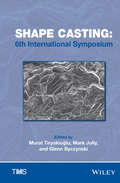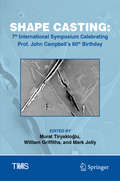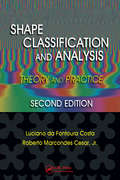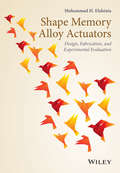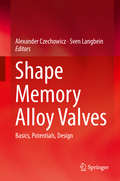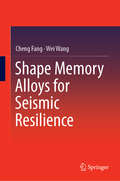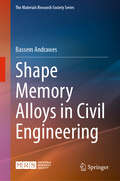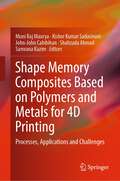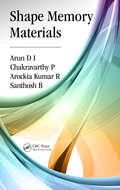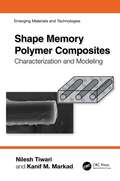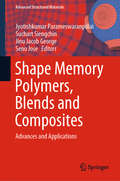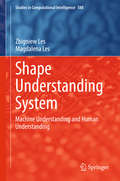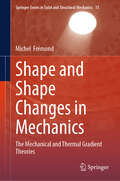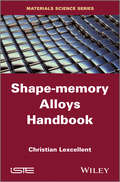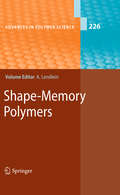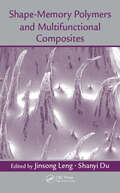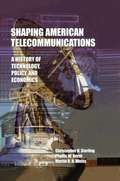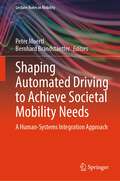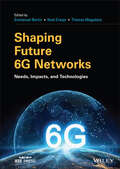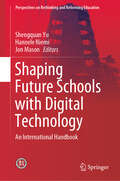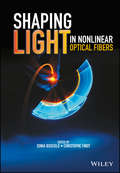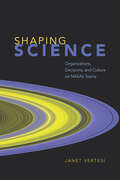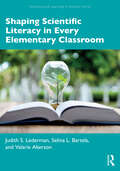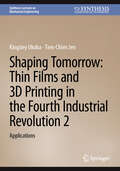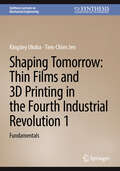- Table View
- List View
Shape Casting
by Tms Murat Tiryakioǧlu Mark Jolly Glenn ByczynskiThis collection presents papers on the science, engineering, and technology of shape castings, with contributions from researchers worldwide. Among the topics that are addressed are structure-property-performance relationships, modeling of casting processes, and the effect of casting defects on the mechanical properties of cast alloys.
Shape Casting: 7th International Symposium Celebrating Prof. John Campbell's 80th Birthday (The Minerals, Metals & Materials Series)
by Mark Jolly William Griffiths Murat TiryakioğluThis book contains a collection of papers on the science, engineering, and technology of shape casting, with contributions from researchers worldwide. Among the topics that are addressed are the structure-property-performance relationships, modeling of casting processes, and the effect of casting defects on the mechanical properties of cast alloys.
Shape Classification and Analysis: Theory and Practice, Second Edition (Image Processing Series)
by Luciano da Costa Roberto Marcond Cesar, Jr.Because the properties of objects are largely determined by their geometric features, shape analysis and classification are essential to almost every applied scientific and technological area. A detailed understanding of the geometrical features of real-world entities (e.g., molecules, organs, materials and components) can provide important clues about their origin and function. When properly and carefully applied, shape analysis offers an exceedingly rich potential to yield useful applications in diverse areas ranging from material sciences to biology and neuroscience.Get Access to the Authors’ Own Cutting-Edge Open-Source Software Projects—and Then Actually Contribute to Them Yourself! The authors of Shape Analysis and Classification: Theory and Practice, Second Edition have improved the bestselling first edition by updating the tremendous progress in the field. This exceptionally accessible book presents the most advanced imaging techniques used for analyzing general biological shapes, such as those of cells, tissues, organs, and organisms. It implements numerous corrections and improvements—many of which were suggested by readers of the first edition—to optimize understanding and create what can truly be called an interactive learning experience. New Material in This Second Edition Addresses Graph and complex networks Dimensionality reduction Structural pattern recognition Shape representation using graphs Graphically reformulated, this edition updates equations, figures, and references, as well as slides that will be useful in related courses and general discussion. Like the popular first edition, this text is applicable to many fields and certain to become a favored addition to any library. Visit http://www.vision.ime.usp.br/~cesar/shape/ for Useful Software, Databases, and Videos
Shape Memory Alloy Actuators
by Mohammad ElahiniaThis book provides a systematic approach to realizing NiTi shape memory alloy actuation, and is aimed at science and engineering students who would like to develop a better understanding of the behaviors of SMAs, and learn to design, simulate, control, and fabricate these actuators in a systematic approach. Several innovative biomedical applications of SMAs are discussed. These include orthopedic, rehabilitation, assistive, cardiovascular, and surgery devices and tools. To this end unique actuation mechanisms are discussed. These include antagonistic bi-stable shape memory-superelastic actuation, shape memory spring actuation, and multi axial tension-torsion actuation. These actuation mechanisms open new possibilities for creating adaptive structures and biomedical devices by using SMAs.
Shape Memory Alloy Valves
by Alexander Czechowicz Sven LangbeinThis book introduces shape memory alloy technology with a specific focus on valve applications. The authors describe application characteristics as well the current and potential uses of this technology. They include an overview of thermal and electrical valves as well as detailed valve design strategies.
Shape Memory Alloys for Seismic Resilience
by Wei Wang Cheng FangThis book introduces readers to the fundamental properties and practical applications of shape memory alloys (SMAs) from the perspective of seismic engineering. It objectively discusses the superiority of this novel class of materials, which could potentially overcome the limitations of conventional seismic control technologies. The results, vividly presented in the form of tables and figures, are demonstrated with rigorous experimental verifications, supplemented by comprehensive numerical and analytical investigations. The book allows readers to gain an in-depth understanding of the working mechanisms of various SMA-based structural devices and members, including beam-to-column connections, dampers, and braces, while also providing them with a broader vision of next-generation, performance-based seismic design for novel adaptive structural systems. Helping to bridge the gap between material science and structural engineering, it also sheds light on the potential of commercializing SMA products in the construction industry. The cutting-edge research highlighted here provides technical incentives for design professionals, contractors, and building officials to use high-performance and smart materials in structural design, helping them stay at the forefront of construction technology.
Shape Memory Alloys in Civil Engineering (The Materials Research Society Series)
by Bassem AndrawesThis book presents a new class of metallic materials, called shape memory alloys (SMAs), as emerging materials for civil engineering applications. These materials have been used for decades in high-end fields like the aerospace and biomedical fields, and possess extraordinary properties that have attracted the attention of civil engineering researchers and practitioners for over 25 years. In this volume, based on 20 years of research findings, the author describes how SMAs started to find their way into practical applications in civil engineering. And that, like any metal, SMAs are produced in any shape, size, or form including wire, bar, and sheet, but unlike other metals, SMAs exhibit a unique ability to recover their original shape/size after being excessively deformed. Given the demand for sustainability and resilience in civil engineering applications, this book is ideal for civil engineering practitioners and materials researchers concerned with building materials and civil infrastructure.
Shape Memory Composites Based on Polymers and Metals for 4D Printing: Processes, Applications and Challenges
by Kishor Kumar Sadasivuni John-John Cabibihan Shahzada Ahmad Samrana Kazim Muni Raj MauryaShape Memory Composites Based on Polymers and Metals for 4D Printing is a thorough discussion of the physics and chemistry behind this developing area of materials science. It provides readers with a clear exposition of shape-memory-composite (SMC) preparation techniques for 3D and 4D printing processes and explains how intelligent manufacturing technology may be applied in fields such as robotics, construction, medical science, and smart sensors. The book covers fundamental background knowledge on the synthesis of shape memory polymers (SMPs) and shape memory alloys (SMAs), and additive manufacturing techniques. Polymers and metals and their roles in 4D printing are dealt with separately, and applications of 4D printing are treated in their own chapter. The different alloy compositions and nanoparticle fillers in polymer composites are examined in detail, along with the key mechanisms involved in their processing. Hybrid nanofillers and synergistic composite mixtures, which are either in extensive current use or have shown promising outcomes in the field of 4D printing, are thoroughly discussed. Differences between these novel SMCs and traditional metal alloys, organic and inorganic composites are presented, and means by which they can improve mechanical properties that are triggered by external sources like magnetic field, temperature, and pH of solvent, are set out. This book provides practitioners, industrial researchers, and scholars with a state-of-the-art overview of SMP/SMA synthesis, additive manufacturing, modification in synthesis of SMCs for 4D printing, and their likely future applications.
Shape Memory Materials
by Chakravarthy P Arockia Kumar R Santhosh B Arun D IThis work addresses the basic principles, synthesis / fabrication and applications of smart materials, specifically shape memory materials <P><P>Based on origin, the mechanisms of transformations vary in different shape memory materials and are discussed in different chapters under titles of shape memory alloys, ceramics, gels and polymers <P><P>Complete coverage of composite formation with polymer matrix and reinforcement filler conductive materials with examples
Shape Memory Polymer Composites: Characterization and Modeling (Emerging Materials and Technologies)
by Nilesh Tiwari Kanif M. MarkadShape Memory Polymer Composites discusses the fabrication of smart polymer composites with their material characterization. It covers shape memory polymer composites with two different types of reinforcement: shape memory polymer nanocomposites and shape memory hybrid composites. Enhancing the mechanical and thermomechanical properties of the shape memory polymers makes them an important class of materials for new age applications ranging from aerospace, biomedical, electronics, to marine engineering. The book discusses how shape memory polymer composites exhibit remarkable mechanical properties, as compared to its corresponding shape memory polymers, without compromising the shape memory behavior. It presents experimental case studies of polymers, polymer composites, and multiphase composites, explaining the effects of each reinforcement on the material properties with corresponding simulation. The book will be a useful reference for industry professionals and researchers involved with the mechanics of shape memory materials.
Shape Memory Polymers, Blends and Composites: Advances and Applications (Advanced Structured Materials #115)
by Jyotishkumar Parameswaranpillai Suchart Siengchin Jinu Jacob George Seno JoseThis book explores the recent advances in the field of shape memory polymers, whose ease of manufacturing and wide range of potential applications have spurred interest in the field. The book presents details about the synthesis, processing, characterization, and applications of shape memory polymers, their blends and composites. It provides a correlation of physical properties of shape memory polymers with macro, micro and nano structures. The contents of this book will be of interest to researchers across academia and industry.
Shape Understanding System
by Zbigniew Les Magdalena LesThis is the third book presenting selected results of research on the further development of the shape understanding system (SUS) carried out by authors in the newly founded Queen Jadwiga Research Institute of Understanding. In this book the new term Machine Understanding is introduced referring to a new area of research aiming to investigate the possibility of building machines with the ability to understand. It is presented that SUS needs to some extent mimic human understanding and for this reason machines are evaluated according to the rules applied for the evaluation of human understanding. The book shows how to formulate problems and how it can be tested if the machine is able to solve these problems.
Shape and Shape Changes in Mechanics: The Mechanical and Thermal Gradient Theories (Springer Series in Solid and Structural Mechanics #15)
by Michel FrémondThis book provides an innovative description of motion with large deformations and the possibility of defects and dislocations. The theory is based on the stretch and angular matrices of the polar decomposition allowing convex potentials. Third-order gradient theories are required to account for mechanical everyday experiments, for instance assemblies of solid structures with different spatial dimensions. Second-order gradient theories are required for thermal experiments. Using the principle of virtual power and new convex potentials, the position of either solid or fluid structures together with the matrix accounting for the defects and dislocations is computed. Defects and dislocations are present in case an internal stress is large enough. Engineers and scientists active in solid and fluid engineering, mathematics, and numerics should be aware of this predictive theory. Damage, shape memory alloys, Cosserat materials, and surface tension are investigated in this framework.
Shape-Memory Alloys Handbook (Wiley-iste Ser.)
by Christian LexcellentThe aim of this book is to understand and describe the martensitic phase transformation and the process of martensite platelet reorientation. These two key elements enable the author to introduce the main features associated with the behavior of shape-memory alloys (SMAs), i.e. the one-way shape-memory effect, pseudo-elasticity, training and recovery. Attention is paid in particular to the thermodynamical frame for solid materials modeling at the macroscopic scale and its applications, as well as to the particular use of such alloys – the simplified calculations for the bending of bars and their torsion. Other chapters are devoted to key topics such as the use of the “crystallographical theory of martensite” for SMA modeling, phenomenological and statistical investigations of SMAs, magneto-thermo-mechanical behavior of magnetic SMAs and the fracture mechanics of SMAs. Case studies are provided on the dimensioning of SMA elements offering the reader an additional useful framework on the subject. Contents 1. Some General Points about SMAs. 2. The World of Shape-memory Alloys. 3. Martensitic Transformation. 4. Thermodynamic Framework for the Modeling of Solid Materials. 5. Use of the “CTM” to Model SMAs. 6. Phenomenological and Statistical Approaches for SMAs. 7. Macroscopic Models with Internal Variables. 8. Design of SMA Elements: Case Studies. 9. Behavior of Magnetic SMAs. 10. Fracture Mechanics of SMAs. 11. General Conclusion. Appendix 1. Intrinsic Properties of Rotation Matrices. Appendix 2. “Twinning Equation” Demonstration. Appendix 3. Calculation of the Parameters a, n and Q from the “Twinning” Equation. Appendix 4. “Twinned” Austenite/Martensite Equation. About the Authors Christian Lexcellent is Emeritus Professor at the École National Supérieure de Mécanique et des Microtechniques de Besançon and a researcher in the Department of Applied Mechanics at FEMTO-ST in France. He is a specialist in the mechanics of materials and phase transition and has taught in the subjects of mechanics of continuum media and shape memory alloys. He is also a member of the International Committee of ESOMAT.
Shape-Memory Polymers
by Andreas LendleinTable of Contents -Shape-Memory Polymers and Shape-Changing Polymers By M. Behl, J. Zotzmann, and A. Lendlein -Shape-Memory Polymer Composites By Samy A. Madbouly and Andreas Lendlein -Characterization Methods for Shape-Memory Polymers By W. Wagermaier, K. Kratz, M. Heuchel, and A. Lendlein -Shape-Memory Polymers for Biomedical Applications By Christopher M. Yakacki and Ken Gall -Controlled Drug Release from Biodegradable Shape-Memory Polymers By ChristianWischke, Axel T. Neffe, and Andreas Lendlein
Shape-Memory Polymers and Multifunctional Composites
by Shanyi Du Jinsong LengAdmired for their extraordinary stimuli-sensitive behavior and shape-changing capabilities, shape-memory polymers (SMPs) and multifunctional composites are among the most important smart materials. They continue to be widely applied in many diverse fields to create things such as self-deployable spacecraft structures, morphing structures, SMP foams
Shaping American Telecommunications: A History of Technology, Policy, and Economics (LEA Telecommunications Series)
by Christopher H. Sterling Phyllis W. Bernt Martin B.H. WeissShaping American Telecommunications examines the technical, regulatory, and economic forces that have shaped the development of American telecommunications services. This volume is both an introduction to the basic technical, economic, and regulatory principles underlying telecommunications, and a detailed account of major events that have marked development of the sector in the United States. Beginning with the introduction of the telegraph and continuing through to current developments in wireless and online services, authors Christopher H. Sterling, Phyllis W. Bernt, and Martin B.H. Weiss explain each stage of telecommunications development, examining the interplay among technical innovation, policy decisions, and regulatory developments.Offering an integrated treatment of the interplay among technology, policy, and economics as key factors defining the development of the telecommunications sector in the United States, this volume also provides:*background material to facilitate understanding of each sector;*contexts for many so-called "new" issues, problems, and trends, demonstrating origins from years or decades in the past; and*careful annotation, documentation, and reference tables to enable further research on the topics discussed.This unique multidisciplinary approach provides a balanced view of U.S. telecommunications history, in context with relevant economic, legal, social, and technical analyses. As such, it is essential reading for advanced students in telecommunications needing to understand how the telecommunications industry and service developed to its current form. The volume will also serve as a supplemental text in courses on telecommunications regulation, and it will be of value to professionals in the field seeking context and background for their daily work.
Shaping Automated Driving to Achieve Societal Mobility Needs: A Human-Systems Integration Approach (Lecture Notes in Mobility)
by Peter Moertl Bernhard BrandstaetterThis edited book describes novel human-systems integration approaches to improve acceptance, safety, and comfort of automated vehicles. Each chapter analyses different aspects in the development of automated driving systems such as: assessing needs and opportunities of specific user populations i.e. elderly drivers and truck drivers; creating fluid human-systems interactions in the vehicle to answer specific driver needs; developing an automated driving tutoring application; and identifying benefits of including road infrastructure sensors to support automated driving predictability. A detailed description of the assessment of the above-described solutions in real-world situations is also included. Written by both researchers and professionals, this book offers timely and practice-oriented information concerning the development of automated driving systems that better adapt to the users’ needs.
Shaping Future 6G Networks: Needs, Impacts, and Technologies (IEEE Press)
by Emmanuel Bertin Noel Crespi Thomas MagedanzShaping Future 6G Networks Discover the societal and technology drivers contributing to build the next generation of wireless telecommunication networks Shaping Future 6G Networks: Needs, Impacts, and Technologies is a holistic snapshot on the evolution of 5G technologies towards 6G. With contributions from international key players in industry and academia, the book presents the hype versus the realistic capabilities of 6G technologies, and delivers cutting-edge business and technological insights into the future wireless telecommunications landscape. You’ll learn about: Forthcoming demand for post 5G networks, including new requirements coming from small and large businesses, manufacturing, logistics, and automotive industry Societal implications of 6G, including digital sustainability, strategies for increasing energy efficiency, as well as future open networking ecosystems Impacts of integrating non-terrestrial networks to build the 6G architecture Opportunities for emerging THz radio access technologies in future integrated communications, positioning, and sensing capabilities in 6G Design of highly modular and distributed 6G core networks driven by the ongoing RAN-Core integration and the benefits of AI/ML-based control and management Disruptive architectural considerations influenced by the Post-Shannon Theory The insights in Shaping Future 6G Networks will greatly benefit IT engineers and managers focused on the future of networking, as well as undergraduate and graduate engineering students focusing on the design, implementation, and management of mobile networks and applications.
Shaping Future Schools with Digital Technology: An International Handbook (Perspectives on Rethinking and Reforming Education)
by Shengquan Yu Hannele Niemi Jon MasonThis book presents an overview of education technology and its use in schools, with a primary emphasis on best practices of technology enhanced learning; how new technologies such as mobile, augmented and wearable technologies affect instructional design strategies; and the content curriculum development process. Providing insights into the future of education and the upcoming pedagogies that will be applied in schools, it helps educators and other stakeholders make innovations for the new generations of learners in the 21st century.The use of emerging technologies such as mobile and ubiquitous technologies, context-aware technology, augment-reality, and virtual reality is contributing to making education adaptive and smarter. With the ever-changing technologies, how to equip teachers with these digital skills and transform their teaching style is also important to ensure that school education is more individualised and customised for students.Offering a global perspective with integrated practical cases, this timely book is of interest to educators, teachers, and education policymakers. And although most of the authors are from the academia, it provides non-experts with a novel view of what future schools will be like with the help of technology.
Shaping Light in Nonlinear Optical Fibers
by Christophe Finot Sonia BoscoloThis book is a contemporary overview of selected topics in fiber optics. It focuses on the latest research results on light wave manipulation using nonlinear optical fibers, with the aim of capturing some of the most innovative developments on this topic. The book’s scope covers both fundamentals and applications from both theoretical and experimental perspectives, with topics including linear and nonlinear effects, pulse propagation phenomena and pulse shaping, solitons and rogue waves, novel optical fibers, supercontinuum generation, polarization management, optical signal processing, fiber lasers, optical wave turbulence, light propagation in disordered fiber media, and slow and fast light. With contributions from leading-edge scientists in the field of nonlinear photonics and fiber optics, they offer an overview of the latest advances in their own research area. The listing of recent research papers at the end of each chapter is useful for researchers using the book as a reference. As the book addresses fundamental and practical photonics problems, it will also be of interest to, and benefit, broader academic communities, including areas such as nonlinear science, applied mathematics and physics, and optical engineering. It offers the reader a wide and critical overview of the state-of-the-art within this practical – as well as fundamentally important and interesting – area of modern science, providing a useful reference which will encourage further research and advances in the field.
Shaping Science: Organizations, Decisions, and Culture on NASA’s Teams
by Janet VertesiIn Shaping Science, Janet Vertesi draws on a decade of immersive ethnography with NASA’s robotic spacecraft teams to create a comparative account of two great space missions of the early 2000s. Although these missions featured robotic explorers on the frontiers of the solar system bravely investigating new worlds, their commands were issued from millions of miles away by a very human team. By examining the two teams’ formal structures, decision-making techniques, and informal work practices in the day-to-day process of mission planning, Vertesi shows just how deeply entangled a team’s local organizational context is with the knowledge they produce about other worlds. Using extensive, embedded experiences on two NASA spacecraft teams, this is the first book to apply organizational studies of work to the laboratory environment in order to analyze the production of scientific knowledge itself. Engaging and deeply researched, Shaping Science demonstrates the significant influence that the social organization of a scientific team can have on the practices of that team and the results they yield.
Shaping Scientific Literacy in Every Elementary Classroom (Teaching and Learning in Science Series)
by Judith S. Lederman Selina L. Bartels Valarie AkersonThis textbook guides teachers in enacting science instruction that results in the cultivation of scientifically literate students in elementary school. Prompting discussions in the pre-service environment around what it means to be scientifically literate, this book helps teachers introduce children to their world through science and its impact on their daily lives. Chapters show teachers how to design, implement, and assess inquiry-based science instruction through lessons that authentically model real science, investigating questions with multiple solutions, and discussing how these lessons build students’ scientific literacy. Sample lessons are modeled on research and tested practice while also recognizing the need to accommodate a diverse range of students and classroom contexts. Ideal for pre-service science teachers, as well as in-service professional development, this book can be used in any elementary science methods course or wherever state or national standards require developing scientific literacy. In helping teachers produce scientifically literate students, it is a resource that enables students to have the content knowledge, attitudes, and abilities to see the role science plays in issues from the personal to the global.
Shaping Tomorrow: Applications (Synthesis Lectures on Mechanical Engineering)
by Tien-Chien Jen Kingsley UkobaThis two-volume work explores the convergence of thin films and 3D printing within the Fourth Industrial Revolution (4IR), targeting engineers, researchers, students, and professionals. The book begins by elucidating Industry 4.0 and its pivotal drivers, emphasizing the integration of advanced digital technologies, automation, and data-driven insights. Subsequent chapters look into the history, properties, and emerging trends of thin films, showcasing their diverse applications in flexible electronics, green hydrogen production, battery technologies, solar technology, and high-performance displays and lighting. Additionally, it explores the transformative role of 3D printing across industries, from aerospace and automotive to healthcare and consumer goods. The work meticulously addresses challenges and opportunities in adopting these technologies, advocating for collaboration, innovation, and continuous improvement. Lastly, it underscores the integration of thin films and 3D printing, highlighting their synergistic potential in driving innovation, customization, and sustainability in manufacturing and beyond. The work serves as an insightful guide, offering valuable perspectives and insights into the applications and relevance of thin films and 3D printing in the 4IR landscape. This second volume deals with concrete applications.
Shaping Tomorrow: Fundamentals (Synthesis Lectures on Mechanical Engineering)
by Tien-Chien Jen Kingsley UkobaThis two-volume work explores the convergence of thin films and 3D printing within the Fourth Industrial Revolution (4IR), targeting engineers, researchers, students, and professionals. The book begins by elucidating Industry 4.0 and its pivotal drivers, emphasizing the integration of advanced digital technologies, automation, and data-driven insights. Subsequent chapters look into the history, properties, and emerging trends of thin films, showcasing their diverse applications in flexible electronics, green hydrogen production, battery technologies, solar technology, and high-performance displays and lighting. Additionally, it explores the transformative role of 3D printing across industries, from aerospace and automotive to healthcare and consumer goods. The work meticulously addresses challenges and opportunities in adopting these technologies, advocating for collaboration, innovation, and continuous improvement. Lastly, it underscores the integration of thin films and 3D printing, highlighting their synergistic potential in driving innovation, customization, and sustainability in manufacturing and beyond. The work serves as an insightful guide, offering valuable perspectives and insights into the applications and relevance of thin films and 3D printing in the 4IR landscape. This first volume deals with fundamental aspects.
